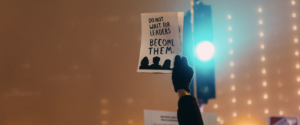I haven’t published new material since October. Basketball season is a convenient excuse, but my season ended over a month ago. Now, I have more unscheduled time than I’ve had since.. well, probably since I was 12 years old. Homeschool life—full circle, now that we’re figuring out “remote learning” on the fly, with teachers and students stuck at home. On the last day of the third quarter in Economics, I told my seniors if I didn’t see them in class again this school year, that it had been an honor to work with them. They laughed, as we hadn’t had any days of school canceled heading into Spring Break. A few days after that it became evident we are definitely not going to be in class through April 13, and everything through 2021 is in limbo.
How do I feel about that? I don’t see much point to going into detail here, since it’s nearly entirely out of my control. I hope this is a once-in-a-lifetime event that we are more prepared for the next time, and I hope our seniors can graduate with a proper ceremony. Oh and I want a real sports banquet, so I can honor my basketball team. Beyond that, I’m focused on observing, learning and making the best of it.
Ever since I’ve had any say in the matter, I’ve compulsively filled my schedule to the brim: friends, athletics, school, work and travel. This day-packing was subconscious for many years, but even after I realized this debatably-unhealthy habit, I haven’t changed. I operate most efficiently on exterior deadlines and I’m a big believer in Parkinson’s Law, so I figure if I choose to commit to a bunch of things I have to do, then I will figure out how and when to do the things I need to do. I’m addicted to the challenge of doing it all and doing it well.
This is the first time an outside force has wrenched control of my schedule out of my hands. If I’m going to be stuck at home, writing is one of the ways I can remain productive, so here I am.
When we hear about something going “viral”, most of us think about the internet. A video, a tweet, an irreplicable flash-in-the-pan. People and companies obsess over trying to identify what it takes to “go viral”, but it’s not an exact science. Over the past few weeks, I’ve been fascinated by observing viral trends in response to this virus. One league cancels games, and the mentality quickly spreads to every league across the entire world. How much of that is based on available data, and how much of it is based on what other decision-makers are doing? One state places restrictions on gatherings, and the rest follow suit. The restriction goes from 5,000, to 500, to 250, 100, 50, 10, to shelter-in place in a matter of days. March Madness, indeed.
The weeks leading into spring break, I started conducting social experiments in virality. A significant portion of our students wear white Nike socks with their school uniform, but social norms dictate the white Nike crew socks are too long to pull straight up the calf and must be double-folded to reduce the length by approximately 3/4 of an inch. You can’t roll them down or have wrinkles, so what other choice is there?! *eye roll* I started folding down the top of my Nike socks so the swoosh was inside out, then initiated conversations where I suggested the “double-fold” method was “trying too hard” (a subject students tend to be particularly sensitive to). Once that trend gained a “foothold”, I escalated it to wearing my socks inside out, so when I folded the top down the Nike sign down the swoosh was right side out but upside down. The final form.
Should I delve into how I toted a yo-yo around school the last three days? No? Probably for the best; we’re over 600 words and I haven’t started my actual topic…
With most of the country confined to their homes and a spirit of fear more prevalent, the viral trends are amplified. The stock market has been making massive runs in both directions, and days with minor changes have become nearly extinct. Just in the last few days, we’ve had a “push-up challenge” sweep Instagram, and some exotic tiger documentary totally dominate the streaming conversation. Posting an “embarrassing” picture on Instagram went from a faux pas to something more and more of the cool kids are doing (for 24 hours). The caption “until tomorrow” applies on multiple levels, because the trend will be gone just as quickly as it arrived. [update: it’s gone already; you missed it]
I would love to do a deep dive into why this happens, but I’ll try to keep it short and relate it back to physical education. Decision are tough, and the easiest way to simplify the infinite variables is through comparison. What are other people doing? How will I be judged if I do something else? It’s easy to follow an existing trend, but it takes something different to start a new trend or intentionally break from the herd. Think about NFL coaches starting to “go for it” on fourth down in more and more situations, or NBA teams taking more and more threes. In both cases, the status quo reigned for decades, and the early adopters were openly questioned, even mocked, despite the “numbers” supporting their argument.
There’s one recent real world example I keep reflecting on, one where I played a role and had a responsibility to make decisions during a viral trend [this is the actual post; you made it!]. It was a Friday in January, our first week back at school. That night was our third annual Alumni Night, which isn’t our biggest event, but certainly is one we had invested significant time and resources toward. My role as athletic director was the same as it usually is, scheduling opponents for our basketball teams, hiring officials, working with the booster club to plan marketing and concessions, and figuring out how to recognize alumni who show up.
It was a beautiful day, sunny and mid 70’s. I had done my due diligence to make sure the evening would go smoothly, and I was excited for the games. As my fourth-period P.E. class was wrapping up, my assistant mentioned something about storms coming our way. I went to my office to check the weather. He was right, at 11 a.m. the National Weather Service had updated a forecast to include Travis County in a severe thunderstorm watch that evening. We aren’t in Travis County, but it’s just south of us. The next several hours were unlike anything I’d experienced before. I was basically communicating non-stop with our league, our opponents, our coaches, my administration, and the booster club, and it seemed like the situation changed just about every time I talked to any of them.
Over the course of the early afternoon, the severe thunderstorm watch transformed into “damaging wind gusts, very large hail, and a few tornadoes”, and Travis County evolved to “much of Central Texas, including Austin and San Antonio”. That’s a massive storm and a lot of territory.
We had three games scheduled, starting at 5 p.m. The last two games were league opponents, and the opener was against a homeschool organization based in San Marcos (south of Austin, well over an hour drive without traffic). If I canceled the league games too early, the opponent had a right to demand a forfeit. If I waited too long to cancel, the homeschool families would be pointlessly stuck in Austin traffic on a late Friday afternoon, which is not something easily forgiven.
It wasn’t just storms I was afraid of, either. Rain alone could ruin the evening easily enough—our gym roof leaks in anything resembling a downpour. We had been fortunate and had not canceled any home games to that point (although we did host a volleyball match last fall where we were mopping the floor between every point #charterschoolproblems). To heighten the uncertainty, we regularly attempt to patch the leaks, only to discover the water has found new openings during the next hard rain. The roof had been worked on since the last storm, so I had reason to *hope* it was fixed but couldn’t pretend to be shocked if it wasn’t.
But can you imagine? We go ahead with the games, opponents brave the trip, fans pack the stands, concessions hot and ready, then water starts streaming from the ceiling, pools of water form on the floor, and everyone has to go home. Worst case scenario. [side note: there has never been a time when someone has said “worst case scenario” accurately—things could always be worse than we can comprehend :-]
It was still sunny. The storm could miss us entirely. The longer I wait the more I know about the weather, but it becomes worse to cancel as the notice gets shorter. What to do?
This situation has been on my mind because it allowed me to experience a microcosm of what our current political leaders are going through. First, a scenario that escalated quickly, with new information streaming in fast enough to completely undermine your most recent conclusion, over and over. Second, a scenario where the “worst case” loomed over my head as something I would be responsible for and the best case scenario didn’t seem worth the risk (even if it was more likely). The third aspect is where trends come into play.
At 1 p.m., Austin ISD canceled all their after-school activities. At 2 p.m., Round Rock ISD, to our east, followed suit. By 4 p.m., every school district in Central Texas fell in line. Some stores even closed.
Because we are a charter school, we are our own district. So, it was still my call. But think about the incentives here, and how blame works. Once one school district made the decision to minimize risk, it makes it appear as if the others are being reckless if they do not. As other districts close and momentum grows, it becomes nearly impossible to resist. Imagine a storm-related incident happening at an after-school event in your district; that would be bad enough. If you were the only district who hadn’t canceled extracurriculars? Exponentially worse. The coverage of Liberty University’s decision to bring back students to campus is a prime example of how this works. It’s almost as if the herd openly roots against those who step out of line. Risk aversion on risk aversion.
The tell-tale sign of this type of thinking is the phrase “out of an abundance of caution”. That basically means “we aren’t sure what to do but we definitely don’t want to go against the grain AND risk the worst-case scenario”. I’m not saying this is bad, or wrong, or overly risk-averse! I am saying I’ve felt it. I understand.
So what did I decide? Well, I got lucky, because the decision was half made for me. Our league opponents canceled, citing Austin ISD’s precedent, then I canceled on the homeschool group, citing our other opponent’s decision. At 3:23 p.m., Leander ISD canceled their events, but I couldn’t have waited that long.
Because I no longer had responsibilities that evening, I went to a happy hour with some faculty. I was paying close attention to the weather, naturally, especially since we were still close to campus.
It didn’t even drizzle.
Yes, I had several people contact me asking why I had decided to cancel the games!
So what’s the point? The point is not that canceling the games was a bad decision. The storm was real; it just didn’t hit us. You can re-evaluate your decision-making process, sure, but it’s not helpful to second-guess that particular scenario. The points are 1) trends are trending, 2) risk aversion is a major factor in leaders’ decision-making, and 3) being a decision-maker is often a lose-lose scenario. Because of 1, 2, and 3, good leadership can never be valued highly enough.
Oh, and maybe 4) predicting the weather seems to be a lot like predicting a virus. The experts aren’t as accurate as they want you to think…


